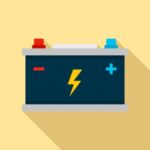This extensive blog series will first explore your combustion engine vehicle’s primary auto electrical system components. It will include a battery, alternator, and starter motor review. Next, we will examine some common malfunctions in driver-controlled and vehicle-controlled electrical systems....
 This extensive blog series will first explore your combustion engine vehicle’s primary auto electrical system components. It will include a battery, alternator, and starter motor review. Next, we will examine some common malfunctions in driver-controlled and vehicle-controlled electrical systems. Finally, we will look at the best ways to care for and maintain the life of your vehicle’s electrical systems. If you drive an electric or hybrid automobile, stay tuned for our specific blog series that address those vehicle types.
This extensive blog series will first explore your combustion engine vehicle’s primary auto electrical system components. It will include a battery, alternator, and starter motor review. Next, we will examine some common malfunctions in driver-controlled and vehicle-controlled electrical systems. Finally, we will look at the best ways to care for and maintain the life of your vehicle’s electrical systems. If you drive an electric or hybrid automobile, stay tuned for our specific blog series that address those vehicle types.
Combustion Engine: Auto Electrical System & Circuits
These days, almost every new car feature and automatic controls rely on its electrical system. Every electric-powered component in your auto works because of an electrical circuit. A circuit is simply a loop of wire that connects the part with the power source (the battery or the alternator). Consequently, electricity continuously flows when the component is in use. Most auto circuits supply power to more than one component. A few of the most common electrical features in today’s vehicles are:
Air conditioning Anti-lock braking Digital gauges and lights in the dashboard External & internal lights Navigation system Power door locks Power/heated seats Power steering Power windows Stereo system Windshield wipersAuto Electricity: The Power of Three
The three main parts of your car’s electrical system are the battery, alternator, and starter motor. In addition, a complex web of circuitry and switches provides the pathway for every electrical component in your vehicle.
Battery
The battery is probably the most essential element in your vehicle’s electrical system. Without it, the simple act of starting your car, turning on the lights, or using the power steering are but a dream. Fortunately, one of the battery’s main roles is to provide power to the starter motor, which then activates the engine’s spark plugs. Another is to give power to the peripheral electrical systems (i.e., interior & exterior lights, stereo, etc.) even while the engine is not running.
Alternator
The alternator produces the electricity needed to power your vehicle’s electrical systems while the engine is running. It has an attached belt, which converts kinetic energy into electricity. The alternator converts an alternating current (AC) to a direct current (DC) before storing it in the vehicle’s battery. Furthermore, it constantly recharges the battery and provides power to electrical features like lights and wipers. This also ensures the battery will have enough stored energy the next time you want to start your car.
Starter Motor
The starter motor has one significant job. The battery sends a considerable amount of energy to the starter motor when you start your car. The starter motor ignites the compression of air and fuel in the engine cylinders and powers the spark plugs. The vehicle’s engine will not start if the battery or the starter motor fails.
Fuses & Fuse Boxes
The wiring of your auto’s electrical circuits are protected from overloads or shorts with fuses. Still, they can only handle a certain amount of amperage. Unfortunately, an electrical short or overload could cause a power surge and endanger the entire circuit. However, most fuses have a delicate metal filament that not only maintains the circuit and breaks to open the circuit. Your car’s fuses are conveniently located together in fuse boxes.
Most cars have two fuse boxes. One is usually located in the engine compartment. It manages circuits for electronic drive features, like anti-lock brakes. Look for the second box in the glove compartment or under the vehicle’s driver’s side dashboard. It holds fuses for the circuits that control the passenger compartment devices, such as the windshield wipers, stereo, and power windows.
Engine Control Unit (ECU)
Most modern Automobiles have an engine control unit (ECU), sometimes called an Engine Control Module (ECM) or Powertrain Control Module (PCM). The ECU is basically a mini-computer connected to various engine and fuel system sensors. The ECU is responsible for many tasks, including:
air-fuel mixture in the engine valve opening timing ignition sequencing engine idle speed other essential drive functions maximize energy efficiency & powerIf the ECU malfunctions or fails, your vehicle may be completely un-drivable. Newer cars are more prone to malfunctions with their ECU, since it runs most of their fuel system sensors.
Common Circuit Malfunctions
Get your vehicle inspected by a technician immediately if you suspect a problem with its ECU or other electronic systems. Any component or function controlled by the ECU is liable to sustain damage unless a qualified technician repairs the system. Your owner’s manual should contain a circuit map explaining which electrical systems operate with each circuit. It can be helpful to reference your owner’s manual when attempting to diagnose a failure in an electrical component.
Auto Electrical System & Circuits Maintenance
You should have your automobile’s electrical system inspected regularly to keep it in good working order. Never ignore minor electrical problems, as they could be symptoms of larger issues, causing serious malfunctions later. In addition, electrical system failures could have disastrous consequences if they occur while driving.
Auto Electrical System Diagnostic Service
Ron’s Garage proudly uses and supports various diagnostic tools, launch scanners, and start testers to diagnose your electrical system. A quick diagnosis can limit unnecessary labor costs. Our skilled technicians utilize electrical and computerized diagnostic measures to determine the source of your vehicle’s issue. This state-of-the-art equipment allows us to narrow down the needed repairs and get you back on the road faster.
Schedule Your Service in Ann Arbor, MI
We would love to hear from you. Call us today at (734) 961-4701 to schedule your appointment or visit us online for all your auto electronic diagnostic service needs.
Next Up: Auto Electrical System Part 2: Systems and Circuits
Our next blog will go into greater detail about your combustion engine vehicle’s electrical systems and circuits.
The post Auto Electrical System Part 1: Overview first appeared on Ron's Garage Ann Arbor Auto Repair.











